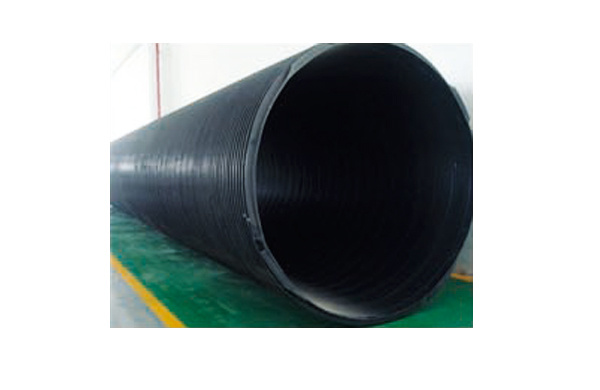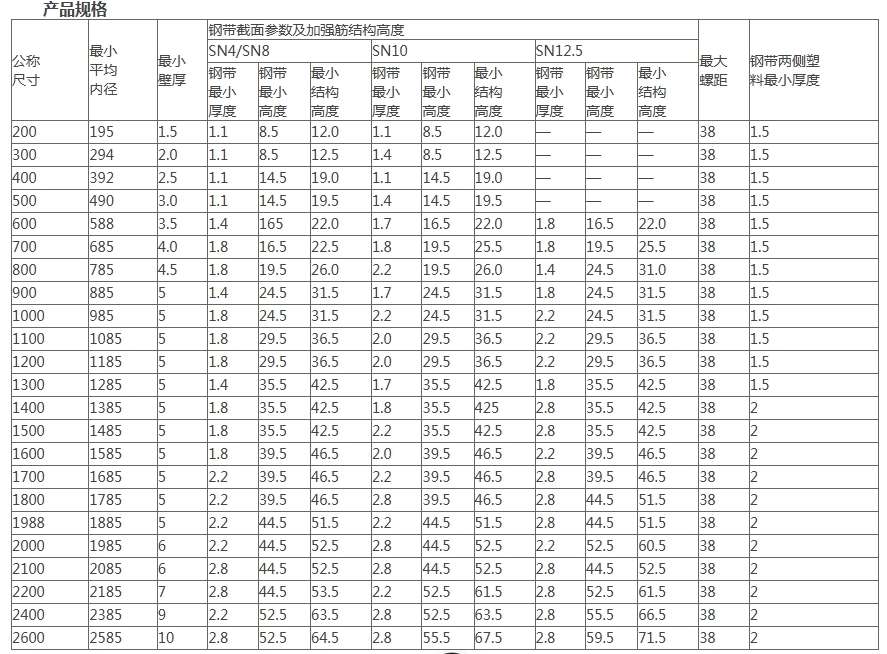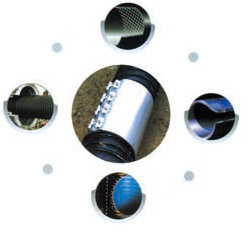 Location: Home/
Kaiyuan Plastic Industry/
Products/
Pipes and pipe fittings/
Polyethylene HDPE plastic steel wound pipe
Location: Home/
Kaiyuan Plastic Industry/
Products/
Pipes and pipe fittings/
Polyethylene HDPE plastic steel wound pipe
HDPE/ plastic-steel wound drainage pipe is a new type of steel-plastic composite gravity self-flow pipe product. It is made by spirally winding and welding steel-plastic composite special-shaped strips and is a green and environmentally friendly product recommended by the Ministry of Construction. Due to the perfect combination of all the advantages of ordinary non-pressure plastic pipes and the high strength of reinforcing steel ribs, plastic-steel wound pipes can meet all the needs in engineering applications and can be widely used in the gravity self-flow transportation of various corrosive or non-corrosive media. Water conservancy projects: used as water source pipes, irrigation pipes/Municipal projects: Used as rainwater pipes, underground drainage pipes, sewage pipes, ventilation pipes, etc. in buildings/Communication pipes: railways, highways
Category:
Polyethylene (HDPE) plastic steel wound pipe
Key words:

HDPE/ plastic-steel wound drainage pipe is a new type of steel-plastic composite gravity self-flow pipe product. It is made by spirally winding and welding steel-plastic composite special-shaped strips and is a green and environmentally friendly product recommended by the Ministry of Construction. Due to the perfect combination of all the advantages of ordinary non-pressure plastic pipes and the high strength of reinforcing steel ribs, plastic-steel wound pipes can meet all the needs in engineering applications and can be widely used in the gravity self-flow transportation of various corrosive or non-corrosive media.
Water conservancy projects
Used as water source pipes, irrigation pipes/Municipal engineering: used as rainwater pipes, underground drainage pipes, sewage pipes, ventilation pipes, etc. in buildings/Communication pipes: protective pipes for railway and highway communication, communication cables, optical cables, etc. / Industry: Widely used as sewage pipes in industrial fields/Agricultural engineering: Used for irrigation and drainage in farmlands, orchards, tea gardens and forest belts/Road engineering Used as seepage and drainage pipes for railways and expressways/Mines: used as ventilation, air supply, drainage and slurry pipes for mines/Sports fields: used as seepage and drainage pipes for golf courses, football fields and other sports venues/Large port and wharf projects: drainage and sewage pipes for large airports, ports and wharf projects, etc. / Water storage systems Water storage systems for intercepting slow water flow/landfill sewage collection pipes/seawater transportation pipes.
Product performance characteristics
Safety ring stiffness guarantee: Compared with pure plastic steel, the reinforced steel strip ensures that the steel has sufficient safety and reliable ring stiffness.
Low coefficient of friction: The inner wall of polyethylene (HDPE) pipes is smooth, which is 20-30% lower than that of cement pipes. Moreover, the sediment is not prone to accumulate in the pipeline, and the frictional resistance remains almost unchanged after long-term use.
Strong sealing performance: Both the stainless steel hoop connection and the electrofusion tape connection are simple and reliable, achieving zero leakage.
Corrosion resistance and long service life: As the steel belt is compounded with high-density polyethylene (HDPE), it has excellent corrosion resistance and a service life of up to 50 years.
Easy installation: Light in weight, no large transportation equipment is required during installation. Good axial flexibility, and low requirements for the flatness and firmness of the trench bottom during laying.
Strong resistance to abnormal sudden loads: The pipe can relieve the excessive pressure generated thereby through elastic deformation, avoiding leakage or damage caused by permanent deformation at the pipe connection.
Excellent comprehensive performance and high cost performance: Combining the advantages of both steel and plastic materials, this pipe has outstanding comprehensive performance and good cost performance.



Stainless steel hoop connection
Stainless steel hoop connection is a connection method that uses mechanical fastening to join the ends of adjacent pipes into one. The connection structure consists of three layers. The innermost layer is a thin-walled rubber sleeve, which is tightly sleeved over the pipe end to serve a sealing function. The middle layer is a foamed rubber sheet of a certain thickness with good elasticity, which serves as a filler. The outer layer is a stainless steel clamp. The sealing effect is achieved by pressing the inner rubber sleeve against the fastening force of the bolts on the stainless steel clamp. The main function of the foamed rubber plate is to evenly transfer the pressure of the stainless steel clamp to the inner sealing rubber plate, thereby eliminating the influence of factors such as uneven surface at the pipe end, uneven height of the ribs and ellipticity on the sealing performance. This linking method is applicable to polyethylene plastic-steel wound pipes with a diameter of DN≤1200mm.
Connection features: The construction process and tools used for stainless steel clamp connection are simple. The interface has strong adaptability to the ellipticity of the pipe opening and the deformation of the foundation, good sealing performance, reliable connection, and fast repair speed in case of an accident.
Electric heat fusion tape connection
Electric heat fusion tape connection is a connection method that uses the high temperature generated by the electric heating elements embedded on the surface of the heat fusion tape when powered on to fuse the contact surfaces into a whole. Electric heat fusion tape is a plastic tape made of the same plastic as the pipe material, with a certain width and a thickness greater than the wall thickness of the pipe and a length greater than the circumference of the pipe. One side of the surface of the plastic tape is inlaid with an electric heat wire mesh to form a circuit. Place the electric heat fusion tape on the inner wall of the end of the pipe to be connected. Use a special fixture to press and tightly adhere the electric heat fusion tape to the inner wall of the pipe. Use a dedicated power supply to power the electric heat fusion tape. Due to the thermal effect of the current, the heating wire melts the pipe wall and the surface of the electric heat fusion tape, forming a whole. After cooling, a reliable connection is formed. This connection method is applicable to plastic-steel wound pipes made of polyethylene with a pipe diameter DN≥1200mm. Connection features: The interface material of the electric heat fusion tape connection is the same as that of the pipe material. The interface and the pipe have the same corrosion resistance and service life. It has good sealing performance and reliable connection. During construction, some parts do not need to dig operation pits.